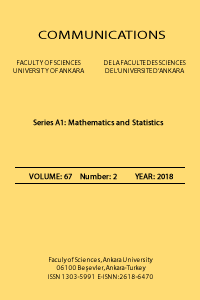ESTIMATING THE EARTHQUAKE SOURCE PARAMETERS: SIMULATED ANNEALING VERSUS NELDER-MEAD SIMPLEX ALGORITHM
The parameter estimation is an important process in many earthscience problems in order to define the features of ground movement. It is clearthat the model nonlinearity makes the estimation of parameters more di¢ cultand more challenging. In this case, metaheuristic algorithms and derivativefree optimization methods are more proper than classical optimization methods. In this study, Simulated Annealing (SA), a well known metaheuristicalgorithm, and Nelder-Mead simplex algorithm, a derivative free optimizationmethod, are used to estimate the earthquake source parameters. The algorithms are applied on a synthetically generated data set. The estimated parameter results show that the SA is better than Nelder-Mead simplex method
Keywords:
Simulated Annealing, Nelder-Mead simplex algorithm parameter estimation, fault plane parameters,
___
- Abbasi, B., Jahromi, A.H.E., Arkat, J. and Hosseinkouchack, M., Estimating the parame- ters of Weibull distribution using simulated annealing algorithm, Applied Mathematics and Computation, 183, 85-93, (2006)
- Abdel-Fattah, A.K., An approach to investigate earthquake source processes, Acta Geophys- ica Polonica, 51(3), 257-269, (2003)
- Abdel-Fattah, A.K. and Badaway, A., Source Characteristics and Tectonic Implications of Moderate Earthquake, Northeastern Cairo Prefecture. Acta Geophysica Polonica, 52(1), 29-43, (2004)
- Aktu¼g, B., A Dynamic Approach to Elastic Half Space Models and Earthquake Coordinate Relocations, Map Journal, 129, 1-16, (2003)
- Ateya, I.L. and Takemoto, S., Gravity inversion modelling across a 2-D dike-like structure-A Case Study, Earth Planet Space, 54, 791-796, (2002)
- Arnadottir, T. and Segall, P., The 1989 Loma Prieta earthquake imaged from inversion of geodetic data, Journal of Geophysical Research, 99(B11), 21835-21855, (1994)
- Carvelli, P., Murray, M.H., Segall, P.,Aoki, Y. and Kato, T., Estimating source parameters from deformation data, with an application to the March 1997 earthquake swarm of Izu Peninsula, Japan, Journal of Geophysical Research, 106(B6),11217-11238, (1999)
- Chang, S.J., Baag, C.E. and Langston, C.A., Joint analysis of teleseismicreceiver functions and surface wave dispersion using the genetic algorithm, Bulletin of the Seismological Society of America, 94, 691-704, (2004)
- Charlety, J., Vallee, M. and Delouis, B., Fast Source Parameter Estimation from Green Func- tion Deconvolution: Application to Shallow Earthquakes. Geophysical Research Abstracts, 10, EGU2008-A-06557, (2008)
- Corana, A., Marchesi, M., Martini, C. and Ridella, S., Minimizing multimodal functions of continuous variables with the “simulated annealing” algorithm. ACM Transactions on Mathematical Software, 13, 262- 280, (1987)
- Del Frate, F., Rossi, F., Schiavon, G. and Stramondo, S., Seismic Source Parameters from InSAR Data Trough Neural Networks, IEEE, 2981-2984, (2004)
- Eglese, R.W., Simulated Annealing: A tool for Operational Research, European Journal of Operational Research, 46, 271-281, (1990)
- Goğe, W.L., Ferrier, G.D. and Rogers, J., Global optimization of statistical functions with simulated annealing, Journal of Econometrics, 60, 65-99, (1994)
- Hedar, A.R., Studies on Metaheuristics for Continuous Global Optimization Problems, 2004, Ph.D. Thesis, Kyoto University, Japan, 148pp.
- Ichinose, G.A., Smith, K.D. and Anderson, J.G., Source Parameters of the 15 November 1995 Border Town, Nevada, Eathquake Sequence, Bulletin Seismological Society of America, 87(3), 652-667, (1997)
- Ingber, L., Very Fast Simulated Re-Annealing, Mathematical Computer Modelling, 12(8), 967-973, (1989)
- Ingber, L., Simulated Annealing: Practice versus Theory, Mathematical Computer Modelling, 18(11), 29-57, (1993)
- Kim W., Hahm I.K., Ahn S.J. and Lim D.H., Determining hypocentral parameters for local earthquakes in 1-D using a genetic algorithm, Geophysical Journal International, 166, 590- 600, (2006)
- Kirkpatrick, S., Gelatt, C.D. and Vecchi, M.P., Optimization by Simulated Annealing, Sci- ence, 220(4598), 671-680, (1983)
- Kumar, B.A., Ramana, D.V., Kumar, Ch.P., Rani, V.S., Shekar, M., Srinagesh, D. and Chadha, R.K., Estimation of source parameters for 14March2005 earthquake of Koyna-Warna region, Current Science, 91(4), 526-530, (2006)
- Li, X., Koike, T. and Pathmathevan, M., A very fast re-annealing (VFSA) approach for land data assimilation, Computers and Geosciences, 30, 239-248, (2004)
- Lin, T.W., Hwang, R.D., Ma, K.F. and Tsai, Y.B., Simultaneous Determination of Earth- quake Source Parameters Using Far-Field P Waves: Focal Mechanism, Seismic Moment, Rup- ture Length and Rupture Velocity, Terrestrial Atmospheric And Oceanic Sciences, 17(3), 463-487, (2006)
- Lomax, A. and Snieder, R., Identifying sets of acceptable solutions to non-linear, geophysical inverse problems which have complicated mis…t functions, Nonlinear Processes in Geophysics, 2, 222-227, (1995)
- Metropolis, N., Rosenbluth, A.W., Rosenbluth, M.N. and Teller, A.H., Equation of State Calculations by Fast Computing Machines, The Journal of Chemical Physics, 21(6), 1087- 1092, (1953)
- Nelder, J.A. and Mead, R., A simplex method for function minimization, Computer Journal, 7, 308-313, (1965)
- Sambridge, M. and Mosegaard, K., Monte-Carlo Methods in Geophysical Inverse Problems, Reviews of Geophysical, 40(3), 1-29, (2002)
- Sharma, S.P. and Kaikkonen, P., Global Optimization of Time Domain Electromagnetic Data Using Very Fast Simulated Annealing, Pure and Applied Geophysics, 155, 149-168, (1999)
- Szu, H. and Hartley, R., Fast Simulated Annealing, Physics Letters A, 122(3,4), 157-162, (1987)
- Türk¸sen, Ö. The Adaptive Simulated Annealing Method in Estimation of Earthquake Search Parameters Through Surface Measuraments, 2005, Master Thesis, 72pp.
- Vasan, A. and Raju, K.S., Comparative analysis of Simulated Annealing, Simulated Quench- ing and Genetic Algorithms for optimal reservoir operation, Applied Soft Computing, 36, 274-281, (2009)
- Xu, T., Wei, H. and Wang, Z.D., Study on continuous network design problem using simulated annealing and genetic algorithm, Expert Systems with Applications, 36, 2735-2741, (2009)
- Current address : Ankara University Faculty of Science, Department of Statistics, 06100, Tan- do¼gan, Ankara,TURKEY
- E-mail address : turksen@ankara.edu.tr, apaydin@ankara.edu.tr
- URL: http://communications.science.ankara.edu.tr/index.php?series=A1
- ISSN: 1303-5991
- Yayın Aralığı: Yılda 4 Sayı
- Başlangıç: 1948
- Yayıncı: Ankara Üniversitesi
Sayıdaki Diğer Makaleler
Sevda SAĞIROĞLU, Erdal GÜNER, Eda KOÇYİĞİT
WATADAíS FUZZY PORTFOLIO SELECTION MODEL AND ITS APPLICATION
